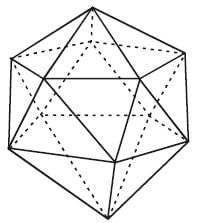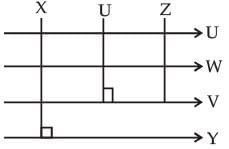Test: Geometry & Mensuration (2019-2010) - UPSC MCQ
10 Questions MCQ Test - Test: Geometry & Mensuration (2019-2010)
A solid cube is painted yellow, blue and black such that opposite faces are of same colour. The cube is then cut into 36 cubes of two different sizes such that 32 cubes are small and the other four cubes are big. None of the faces of the bigger cubes is painted blue. How many cubes have only one face painted?
[2019]
Consider the following three-dimensional figure:

How many triangles does the above figure have?
[2018]

How many triangles does the above figure have?
| 1 Crore+ students have signed up on EduRev. Have you? Download the App |
Twelve equal squares are placed to fit in a rectangle of diagonal 5 cm. There are three rows containing four squares each. No gaps are left between adjacent squares. What is the area of each square?
[2018]
A piece of tin is in the form of a rectangle having length 12 cm and width 8 cm. This is used to construct a closed cube. The side of the cube is:
[2016]
A cylindrical overhead tank of radius 2 m and height 7 m is to be filled from an underground tank of size 5.5 m × 4 m × 6 m. How much portion of the underground tank is still filled with water after filling the overhead tank completely?
[2016]
In a plane, line X is perpendicular to line Y and parallel to line Z; line U is perpendicular to both lines V and W; line X is perpendicular to line V.
Which one of the following statements is correct?
[2015]
A gardener increased the area of his rectangular garden by increasing its length by 40% and decreasing its width by 20%. The area of the new garden
[2014]
Two glasses of equal volume are respectively half and three-fourths filled with milk. They are then filled to the brim by adding water. Their contents are then poured into another vessel. What will be the ratio of milk to water in this vessel?
[2011]
A village having a population of 4000 requires 150 litres of water per head per day. It has a tank measuring 20 m × 15 m × 6 m. The water of this tank will last for
[2011]
The diameters of two circular coins are in the ratio of 1: 3. The smaller coin is, made to roll around the bigger coin till it returns to the position from where the, process of rolling started. How many times the smaller coin rolled around the bigger coin?
[2010]




 ⇒ side = 4 cm.
⇒ side = 4 cm.





















